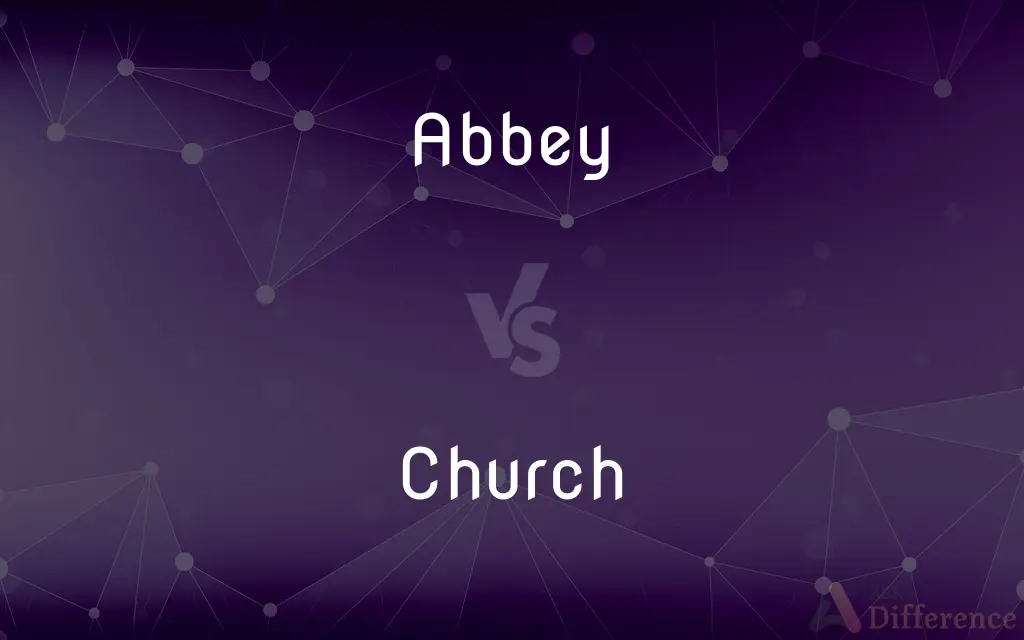Abbey vs. Church — What's the Difference?
By Maham Liaqat & Fiza Rafique — Updated on April 1, 2024
An abbey is a complex including a monastery or convent, under the authority of an abbot or abbess, whereas a church is a place of worship for Christians.

Difference Between Abbey and Church
Table of Contents
ADVERTISEMENT
Key Differences
An abbey, traditionally, is not just a single building but a complex that includes a church as well as accommodations for monks or nuns, living under the vows of poverty, chastity, and obedience. It's led by an abbot or abbess and often has a significant architectural footprint, reflecting its communal and sometimes agricultural operations. Whereas a church is primarily a building or structure designated for Christian worship, where believers gather for services, prayer, and community activities. Churches are led by clergy such as priests, pastors, or ministers, and they can range from simple structures to grand cathedrals.
The primary function of an abbey is to serve as a center for monastic life, where monks or nuns live according to their religious vows. The church within an abbey is used for religious services, but the abbey also includes other facilities such as libraries, dining halls, and workshops. On the other hand, the primary function of a church is to host religious services and sacraments for its congregation, serving as a spiritual and community gathering place.
Abbeys have historically been self-sufficient communities, engaging in farming, brewing, and other crafts to support themselves and help the poor. They played a crucial role in preserving knowledge through their libraries and scriptoriums in the Middle Ages. Churches, while they may engage in community service and support, do not typically include residential or economic functions within their operations.
The leadership structure of an abbey is unique in that it is autonomous, with the abbot or abbess having authority over its operations, including the church services. This leadership is based on monastic rules, such as those written by St. Benedict. In contrast, churches are part of a broader ecclesiastical hierarchy, with clergy reporting to higher church authorities such as bishops or synods, depending on the denomination.
Finally, while both abbeys and churches are built for religious purposes, the former often has historical or cultural significance that transcends its religious function. Many abbeys, especially in Europe, are heritage sites that attract tourists for their architecture and history. Churches, too, can be significant cultural landmarks, but their primary identity remains as places of worship.
ADVERTISEMENT
Comparison Chart
Primary Function
Monastic community living, including worship.
Place of worship for Christians.
Components
Includes a church, living quarters, and often farms/crafts.
Mainly the worship building itself.
Leadership
Led by an abbot/abbess; follows monastic rules.
Led by priests/pastors; follows denominational hierarchy.
Community Role
Self-sufficient, engages in various crafts and agriculture.
Focuses on spiritual services and community support.
Historical Significance
Often heritage sites with significant architecture.
Can be cultural landmarks, primarily as worship sites.
Compare with Definitions
Abbey
Monastic complex.
The abbey, with its tranquil gardens, was home to a community of monks.
Church
Place of worship.
The church stands at the heart of the village, hosting weekly services.
Abbey
Historically significant.
The ancient abbey is a testament to medieval architecture and monastic traditions.
Church
Community gathering spot.
Beyond services, the church hosts events to bring the community together.
Abbey
Center for religious life and work.
The abbey's monks dedicated their lives to prayer and self-sustenance through farming.
Church
Varies in size and architecture.
From humble chapels to majestic cathedrals, churches reflect diverse traditions.
Abbey
Led by an abbot/abbess.
She became the abbess of the abbey, overseeing its operations and spiritual life.
Church
Led by clergy.
The church's pastor is well-regarded for his compassionate outreach.
Abbey
Community of monks or nuns.
The community at the abbey lived in accordance with the Rule of St. Benedict.
Church
Spiritual and sacramental functions.
The church is pivotal for ceremonies like weddings, baptisms, and funerals.
Abbey
An abbey is a type of monastery used by members of a religious order under the governance of an abbot or abbess. Abbeys provide a complex of buildings and land for religious activities, work, and housing of Christian monks and nuns.
Church
A building for public, especially Christian worship.
Abbey
A monastery supervised by an abbot.
Church
The company of all Christians regarded as a spiritual body.
Abbey
A convent supervised by an abbess.
Church
A specified Christian denomination
The Presbyterian Church.
Abbey
A church that is or once was part of a monastery or convent.
Church
A congregation.
Abbey
The office or dominion of an abbot or abbess.
Church
Public divine worship in a church; a religious service
Goes to church at Christmas and Easter.
Abbey
A monastery or society of people, secluded from the world and devoted to religion and celibacy, which is headed by an abbot or abbess; also, the monastic building or buildings.
From 1199 to 1203 William Punchard was the abbot of the abbey of Rievaulx, which was part of the Cistercian order of monks.
Church
The clerical profession; clergy.
Abbey
The church of a monastery.
Church
Ecclesiastical power as distinguished from the secular
The separation of church and state.
Abbey
(British English) A residence that was previously an abbatial building.
Church
To conduct a church service for, especially to perform a religious service for (a woman after childbirth).
Abbey
The church of a monastery.
Church
Of or relating to the church; ecclesiastical.
Abbey
A church associated with a monastery or convent
Church
(countable) A Christian house of worship; a building where Christian religious services take place.
There is a lovely little church in the valley.
This building used to be a church before being converted into a library.
Abbey
A convent ruled by an abbess
Church
Christians collectively seen as a single spiritual community; Christianity; Christendom.
These worshippers make up the Church of Christ.
Abbey
A monastery ruled by an abbot
Church
(countable) A local group of people who follow the same Christian religious beliefs, local or general.
Church
(countable) A particular denomination of Christianity.
The Church of England separated from the Roman Catholic Church in 1534.
Church
Christian worship held at a church; service.
Church
Organized religion in general or a specific religion considered as a political institution.
Many constitutions enshrine the separation of church and state.
Church
Any religious group.
She goes to a Wiccan church down the road.
Church
Assembly.
Church
To conduct a religious service for (a woman after childbirth, or a newly married couple).
Church
(transitive) To educate someone religiously, as in in a church.
Church
(slang) Expressing strong agreement.
- These burritos are the best!
- Church!
Church
A building set apart for Christian worship.
Church
A Jewish or heathen temple.
Church
A formally organized body of Christian believers worshiping together.
Church
A body of Christian believers, holding the same creed, observing the same rites, and acknowledging the same ecclesiastical authority; a denomination; as, the Roman Catholic church; the Presbyterian church.
Church
The collective body of Christians.
Church
Any body of worshipers; as, the Jewish church; the church of Brahm.
Church
The aggregate of religious influences in a community; ecclesiastical influence, authority, etc.; as, to array the power of the church against some moral evil.
Remember that both church and state are properly the rulers of the people, only because they are their benefactors.
Church
To bless according to a prescribed form, or to unite with in publicly returning thanks in church, as after deliverance from the dangers of childbirth; as, the churching of women.
Church
One of the groups of Christians who have their own beliefs and forms of worship
Church
A place for public (especially Christian) worship;
The church was empty
Church
A service conducted in a church;
Don't be late for church
Church
The body of people who attend or belong to a particular local church;
Our church is hosting a picnic next week
Church
Perform a special church rite or service for;
Church a woman after childbirth
Common Curiosities
What is the main difference between an abbey and a church?
An abbey is a monastic community with a church on its premises, while a church is specifically a place of worship.
How do churches contribute to their communities?
Churches serve as places of worship and community gathering, offering spiritual guidance, social support, and various outreach programs.
Can a church become an abbey?
A church itself cannot become an abbey, but an abbey includes a church as part of its larger monastic complex.
Are abbeys and churches always Christian?
While typically Christian, the term "abbey" historically refers to Christian monastic communities, and "church" refers to Christian places of worship.
What role did abbeys play in history?
Abbeys were centers of education, agriculture, and healthcare in medieval Europe, preserving knowledge and supporting the local populace.
Why are some abbeys famous tourist attractions?
Many abbeys are famous for their architectural beauty, historical significance, and the role they played in local and religious history.
Do all abbeys have churches?
Yes, a church is a central feature of an abbey, serving as the location for the monastic community's religious services.
How does the architecture of abbeys and churches differ?
Abbey architecture often includes residential and agricultural buildings, while church architecture focuses on spaces for worship and gathering.
Can anyone visit an abbey?
Many abbeys are open to the public for visits and tours, especially those of historical significance, but some may have restrictions.
Is there a hierarchy within church leadership?
Yes, church leadership is often part of a larger ecclesiastical hierarchy, with clergy reporting up through a system of oversight that varies by denomination.
Can anyone join an abbey?
Joining a monastic community requires a commitment to its religious life and often a period of discernment and training.
What is the significance of the church in a community?
The church is a central place for worship, spiritual growth, and community support, often involved in charitable activities.
What makes a church a cathedral?
A cathedral is a church that serves as the principal church of a diocese, containing the seat (cathedra) of a bishop.
Do monks and nuns still live in abbeys?
Yes, some abbeys still function as monastic communities with monks or nuns living according to their religious vows.
Share Your Discovery

Previous Comparison
Cloning vs. Duplicate
Next Comparison
Skill vs. AssetAuthor Spotlight
Written by
Maham LiaqatCo-written by
Fiza RafiqueFiza Rafique is a skilled content writer at AskDifference.com, where she meticulously refines and enhances written pieces. Drawing from her vast editorial expertise, Fiza ensures clarity, accuracy, and precision in every article. Passionate about language, she continually seeks to elevate the quality of content for readers worldwide.
















































